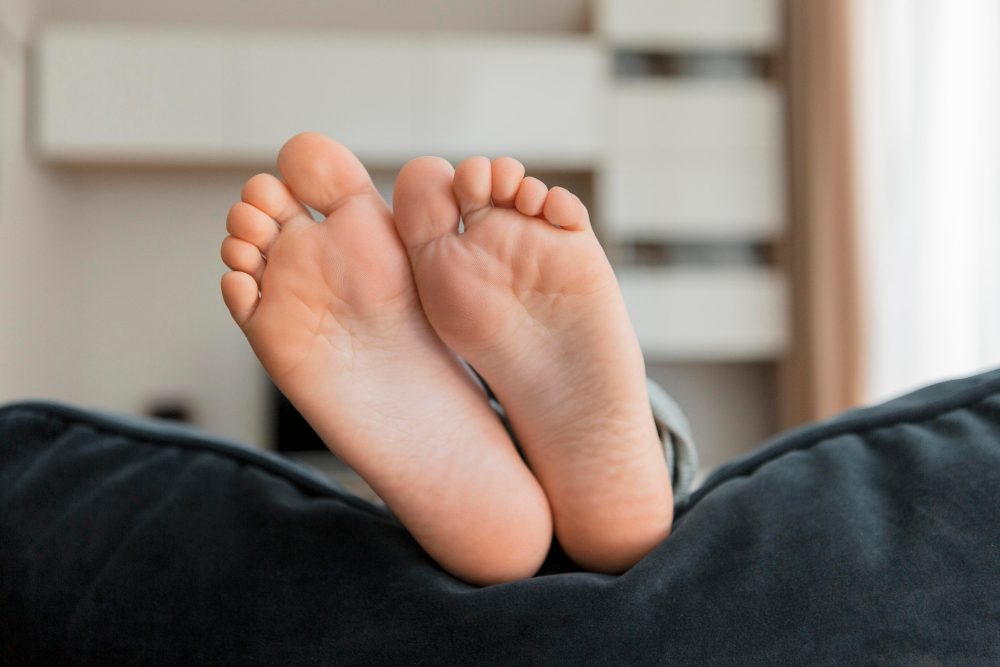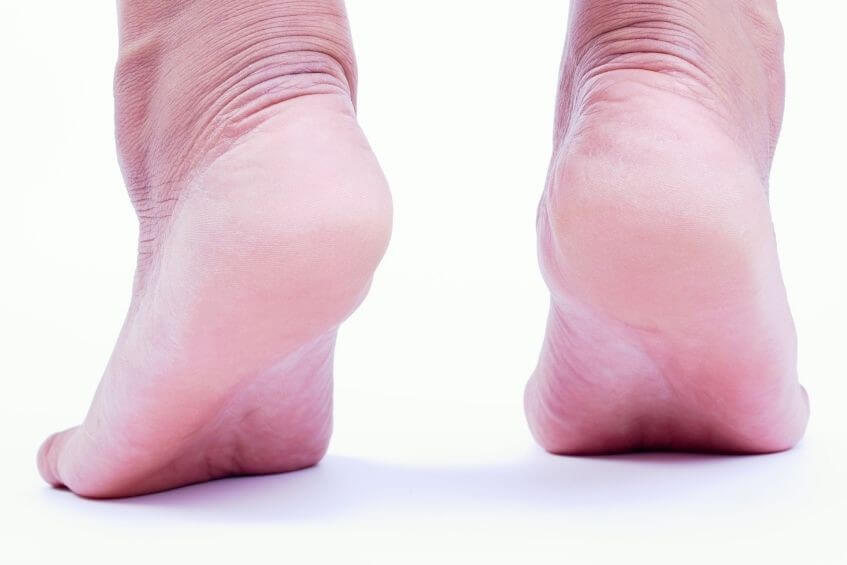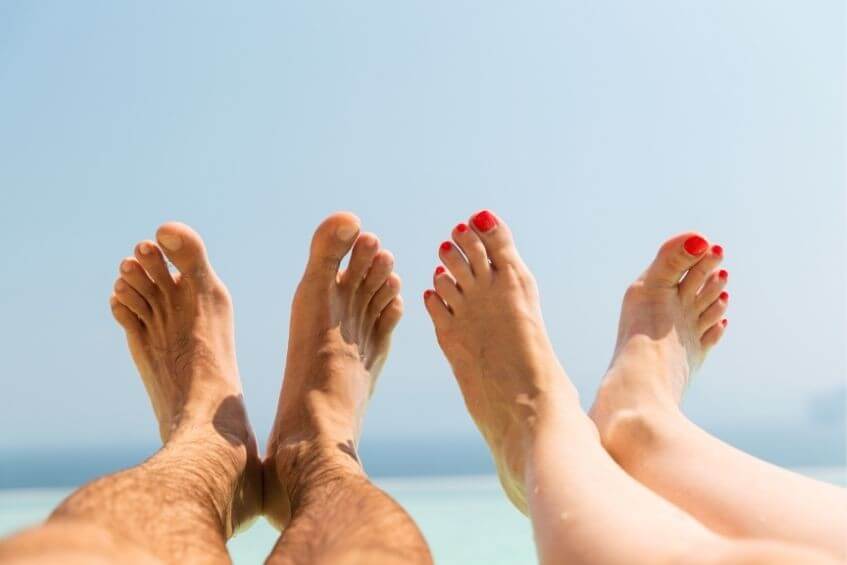
Jump to section
Growing pains aren’t just painful and frustrating for children, they can also see them miss out on their favourite sports and activities with their friends. Our podiatrists treat growing pains by getting down to the root of why they occur - helping get kids back to doing the things they love as quickly as possible.
Growing pains affect children between the ages of 3 and 12 years, often (but not always) during a growth spurt. There’s a common misconception that growing pains are one of those natural problems that are a part of adolescence that kids must see through and wait until they pass themselves, with no available treatment at home or professionally. The truth is that there is always a cause for musculoskeletal pain, and when we identify the cause, knowing which steps to take to help resolve the problem is often straightforward. This is exactly the case for growing pains.
To understand what growing pains are, it’s important to understand how our bones grow. Before our bones mature, they contain specific cartilaginous areas called ‘growth plates’ which our body uses as a construction site to add new bone cells to, and hence grow our bones. Being a work in progress, these growth plates aren’t as strong as the rest of the bone, making them more vulnerable when tension is applied to the bone.
While our bones grow, our muscles do too, lengthening and strengthening, and going through periods of tightness as they lengthen and keep up with the body’s growth. As muscles attach to the bones, they pull and place tension on the bone when kids are moving and active - and it’s the growth plates that become irritated and painful as a result. This is how growing pains start, and continue until the tension on the bone from growing muscles and tendons is reduced and normalised.
Episodes of growing pains are generally frequent, with 43% of children with growing pains being shown to have an attack at least once per week, and some experiencing daily pain for over six months. If your child is experiencing growing pains, they may:
Growing pains at the back of the heels occur when a
tight Achilles tendon that attaches to the heel bone pulls and irritates the growth plate that is present at the back of the heel. The
Achilles is the strongest tendon in the body and exerts tremendous force during running, so this is the most common area we see for growing
pains. This is medically known as Sever’s Disease - but don’t worry, this is not a disease but a condition that we can
help with.
When growing pains develop in the knees, it means that the tendon that comes
down from the thighs and crosses the knee to attach at the top of the shin bone (tibia) has irritated the growth plate in the area,
leading to growing pains at the knee. As this tendon is stretched when the knee is bent, any bending movements like squatting or running
can bring on pain. This is medically known as Osgood Schlatter disease.
 Growing
pains in the midfoot is known as Iselin’s Disease, and affects the middle of the foot, along the outside. This pain is
caused by irritation to the growth plate at the base of the fifth metatarsal (outer long bone of the foot), right where you’ll feel
a natural bony protrusion with your fingers. This time, the tendon responsible for the pulling and irritation is called the peroneus
brevis.
Growing
pains in the midfoot is known as Iselin’s Disease, and affects the middle of the foot, along the outside. This pain is
caused by irritation to the growth plate at the base of the fifth metatarsal (outer long bone of the foot), right where you’ll feel
a natural bony protrusion with your fingers. This time, the tendon responsible for the pulling and irritation is called the peroneus
brevis.
 Kohler
disease is another condition that causes pain, redness and swelling at the navicular bone in the foot. It often occurs in children aged
between five and ten years and is linked to a disruption in the blood supply to the foot which can then cause the bone to die, break or
collapse before healing and hardening. While this condition is rare, if your child experiences pain in this area, it’s important to
bring them in to see a podiatrist as soon as possible.
Kohler
disease is another condition that causes pain, redness and swelling at the navicular bone in the foot. It often occurs in children aged
between five and ten years and is linked to a disruption in the blood supply to the foot which can then cause the bone to die, break or
collapse before healing and hardening. While this condition is rare, if your child experiences pain in this area, it’s important to
bring them in to see a podiatrist as soon as possible.
Freiberg’s infarction describes the premature death of bone, most often at the head of the second metatarsal bone of the foot, due to an interrupted blood supply to the area. Freiberg’s most often affects children or teenagers in their second decade of life, and symptoms can look like pain or stiffness at the ball of the foot, swelling and pain when putting weight on the foot.
Growing pains typically affect children between 3-12 years, but as growth can vary in children, some kids have growing pains later into their adolescence.
Our podiatrists diagnose growing pains by speaking with your child and learning about their pain and symptoms, like when their pain starts, what worsens it, and their daily activities. We then perform a physical examination, part of which involves ruling out other causes of pain like a muscle or a tendon injury, to ensure the right treatment is delivered. This is usually sufficient to help us make a confident diagnosis.
While growing pains can resolve on their own over time, this can take time, and we are confident that we can keep kids playing sport and we
do not promote ceasing activity from social sports and activities which kids are not usually keen to do. To help, you can start making some
simple changes at home, or get a custom treatment plan from our podiatrists to help get your child back on the field and feeling great.
To help treat growing pains at home, you can:
Our Brisbane-based podiatrists work extensively with children to help relieve pain and discomfort, and get kids back to doing the things they love. Based on the results of our assessment, we’ll create a tailored treatment plan to best support the tender area and reduce the stress on the growth plate. The treatment plan may involve:
You can help your child reduce their risk of developing growing pains by:
We see and treat a wide range of children’s foot and leg problems, including:
When it comes to children’s feet and legs, it can sometimes be difficult to tell if there’s a problem, especially if they’re not reporting any pain. We recommend bringing your kids in for a foot check if you’re noticing and concerned about:

Our feet are the foundation for the entire body, so it's important that they have enough strength to tolerate our activity levels. Use
these three exercises to help strengthen your feet.

Not everyone needs orthotics, but they can play an integral role in treating or relieving pain in several foot and lower limb conditions.

The heat and humidity of an Australian summer makes it a prime time for issues to arise, so our newest podiatrist Lucy has put together
seven helpful tips to keep your feet healthy and problem free throughout summer.
| Monday | 7:30am - 6:30pm |
| Tuesday | 7:30am - 6:00pm |
| Wednesday | 7:30am - 6:30pm |
| Thursday |
7:30am - 6:00pm |
| Friday | CLOSED |
| Saturday | CLOSED |
| Sunday | CLOSED |
Ground Floor, 344 Queen Street,
Brisbane City QLD 4000
| Monday | 7:30am - 6:00pm |
| Tuesday | 7:30am - 6:00pm |
| Wednesday | 7:30am - 6:00pm |
| Thursday |
7:30am - 6:30pm |
| Friday | 7:30am - 5:30pm |
| Saturday | 7:30am - 4:30pm |
| Sunday | CLOSED |
Newmarket Village, 114/400 Newmarket Rd, Newmarket QLD 4051